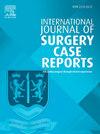妊娠23周附件扭转的处理1例报告
IF 0.6
Q4 SURGERY
引用次数: 0
摘要
附件扭转是一种罕见的妇科急症,在怀孕期间更为罕见,这可能导致诊断延误。由于妊娠晚期卵巢向上移位,其诊断具有挑战性,可以模仿其他手术紧急情况,如阑尾炎或肾盂肾炎。病例报告一名27岁女性,妊娠23周G1P0,表现为急性盆腔伴呕吐。临床及超音波表现为右卵巢扭转,囊肿大小为60 × 40毫米。进行剖腹手术,发现卵巢蒂有两处扭曲,但没有缺血,膀胱切除术完成,妊娠持续至足月,无并发症。附件扭转是妊娠期罕见的紧急情况,通常与卵巢病理如皮样囊肿有关,如我们的病例。由于妊娠期间的非特异性症状和解剖变化,诊断是具有挑战性的,超声是主要工具,MRI是额外的精度。治疗取决于胎龄和附件的生存能力,在17周之前腹腔镜检查是最好的,对于高龄妊娠剖腹手术是最好的。结论妊娠期附件扭转症状不明确,诊断困难。根据安全指南,及时诊断腹腔镜检查对于治疗无反应的持续性疼痛至关重要,以避免延误。本文章由计算机程序翻译,如有差异,请以英文原文为准。
Management of adnexal torsion at 23 weeks of pregnancy a case report
Introduction
Adnexal torsion is a rare gynecological emergency, even more exceptional during pregnancy, which can lead to diagnostic delays. Its diagnosis is challenging due to the upward displacement of the ovary in advanced pregnancy, which can mimic other surgical emergencies like appendicitis or pyelonephritis.
Case report
A 27-year-old woman, G1P0 at 23 weeks of gestation, presented with acute pelvic associated with vomiting. Clinical and ultrasound findings revealed a right ovarian torsion on a 60 × 40 mm dermoid cyst. A laparotomy was performed, showing two twists of the ovarian pedicle without ischemia, and a cystectomy was completed, the pregnancy continued to term without complications.
Discussion
Adnexal torsion is a rare emergency in pregnancy), often linked to ovarian pathology like dermoid cysts, as in our cases. Diagnosis is challenging due to nonspecific symptoms and anatomical changes during pregnancy, with ultrasound as the primary tool and MRI for additional precision.
Management depends on gestational age and adnexal viability, with laparoscopy favored before 17 weeks and laparotomy for advanced pregnancies.
Conclusion
Adnexal torsion is difficult to diagnose in pregnancy due to nonspecific symptoms. Prompt diagnostic laparoscopy, following safety guidelines, is crucial for persistent pain unresponsive to treatment to avoid delays.
求助全文
通过发布文献求助,成功后即可免费获取论文全文。
去求助
来源期刊
CiteScore
1.10
自引率
0.00%
发文量
1116
审稿时长
46 days

 求助内容:
求助内容: 应助结果提醒方式:
应助结果提醒方式:


